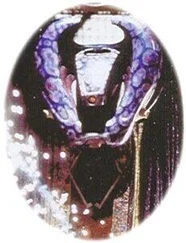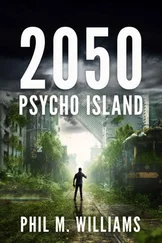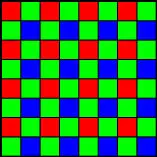
Figure 1.3. The Bayer matrix is by far the most used for sampling colors in cameras
Linear minimum mean-square error demosaicing (Getreuer 2011) suggests working not directly on the three color channels (red, green and blue), but on the pixelwise differences between the green channel and each of the other two channels separately. It interpolates this difference separately in the horizontal and vertical directions, in order to estimate first the green channel, followed by the differences between red and green, and then between blue and green. The red and blue channels can then be recovered by a simple subtraction. This method, as well as many others, makes the underlying assumption that the difference of color channels is smoother than the color channels themselves, and therefore easier to interpolate.
More recently, convolutional neural networks have been proposed to demosaic an image. For instance, demosaicnet uses a convolutional neural network to jointly interpolate and denoise an image (Gharbi et al . 2016; Ehret and Facciolo 2019). Even if these methods offer superior results to algorithms without training, they also require more resources, and are therefore not widely used yet in digital cameras.
The methods described here are only a brief overview of the large array of methods that exist for image demosaicing. This variety is increased by the fact that most industrial cameras do not disclose their often private demosaicing algorithm.
No demosaicing method is perfect – after all, it is a matter of reconstructing missing information – and produces some level of artifacts, although some produce much fewer artifacts than others. Therefore, it is possible to detect these artifacts to obtain information on the demosaicing method applied to the image, which is explained in section 1.4.
White balance aims to adjust values obtained by the sensors, so that they match the colors perceived by the observer by adjusting the gain values of each channel. White balance adjusts the output using characteristics of the light source, so that achromatic objects in the real scene are rendered as such (Losson and Dinet 2012).
For example, white balance can be achieved by multiplying the value of each channel, so that a pixel that has a maximum value in each channel is found to have the same maximum value 255 in all channels.
Then, the image goes through what is known as gamma correction. The charge accumulated by the sensor is proportional to the number of photons incident on the device during the exposure time. However, human perception is not linear with the signal intensity (Fechner 1860). Therefore, the image is processed to accurately represent human vision by applying a concave function of the form  , where γ typically varies between 1.8 and 2.2. The idea behind this procedure is not only to enhance the contrast of the image but also to encode more precisely the information in the dark areas, which are too dark in the raw image.
, where γ typically varies between 1.8 and 2.2. The idea behind this procedure is not only to enhance the contrast of the image but also to encode more precisely the information in the dark areas, which are too dark in the raw image.
Nevertheless, commercial cameras generally do not apply this simple function, but rather a tone curve. Tone curves allow image intensities to be mapped according to precomputed tables that simulate the nonlinearity present in human vision.
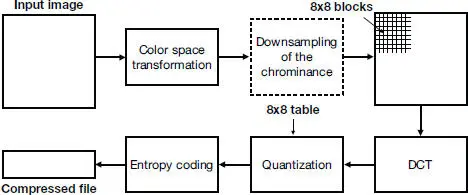
Figure 1.4. JPEG compression pipeline
The stages of the JPEG compression algorithm, illustrated in Figure 1.4, are detailed below. The first stage of the JPEG encoding process consists of performing a color space transformation from RGB to YC BC R, where Y is the luminance component and C Band C Rare the chrominance components of the blue difference and the red difference. Since the Human Visual System (HVS) is less sensitive to color changes than to changes in luminance, color components can be subsampled without affecting visual perception too much. The subsampling ratio generally applied is 4:2:0, which means that the horizontal and vertical resolution is reduced by a factor of 2. After the color subsampling, each channel is divided into blocks of 8 × 8 and each block is processed independently. The discrete cosine transform (DCT) is applied to each block and the coefficients are quantized.
The JPEG quality factor Q , ranging between 1 and 100, corresponds to the rate of image compression. The lower this rate, the lighter the resulting file, but the more deteriorated the image. A quantization matrix linked to Q provides a factor for each component of the DCT blocks. It is during this quantization step that the greatest loss of information occurs, but it is also this step that allows the most space in memory to be saved. The coefficients corresponding to the high frequencies, whose variations the HVS struggles to distinguish, are the most quantized, sometimes going so far as to be entirely canceled.
Finally, as in the example in Figure 1.5, the quantized blocks are encoded without loss to obtain a JPEG file. Each 8 × 8 block is zig-zagged and the coefficients are arranged as a vector in which the first components represent the low frequencies and the last ones represent the high frequencies.
Lossless compression by RLE coding (range coding) then exploits the long series of zeros at the end of each vector due to the strong quantization of the high frequencies, and then a Huffman code allows for a final lossless compression of the data, to which a header is finally added to form the file.
1.3. Traces left on noise by image manipulation
1.3.1. Non-parametric estimation of noise in images
Noise estimation is a necessary preliminary step to most image processing and computer vision algorithms. However, compared to the literature on denoising, research on noise estimation is scarce (Lebrun et al . 2013). Most homoscedastic white noise estimation methods (Lee 1981; Bracho and Sanderson 1985; Donoho and Johnstone 1995, 1994; Immerkær 1996; Mastin 1985; Voorhees and Poggio 1987; Lee and Hoppel 1989; Olsen 1993; Rank et al . 1999; Ponomarenko et al . 2007) follow the same paradigm: they look for flat regions in the image and estimate noise in high frequencies, where noise dominates over signal.
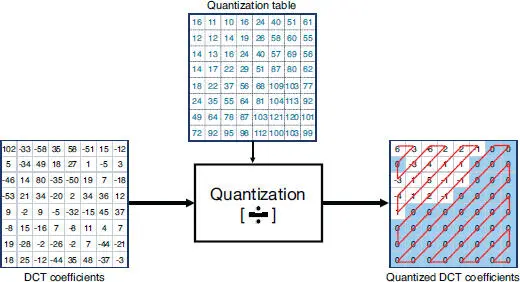
Figure 1.5. An example of the impact of quantization on a DCT block. Each DCT coefficient is quantized by a value found in a quantization matrix. Rounding to the nearest integer results in many of the high-frequency coefficients being set to zero. Each block is zig-zagged to be encoded as a vector with a sequence of zeros
We shall limit ourselves to discuss the method acknowledged as the best estimator for homoscedastic noise in the review (Lebrun et al . 2013), the Ponomarenko et al .’s method (Ponomarenko et al . 2007). This method computes the variance of overlapping 8 × 8 pixels blocks. To avoid the effects of textures and edges, blocks are sorted according to their low-frequency energy; only a small percentile (typically 0.5%) is used to select the blocks whose low- and medium-frequency energy is lowest. The final noise estimation is obtained by computing the median of the variances in the high frequencies of these blocks.
Читать дальше
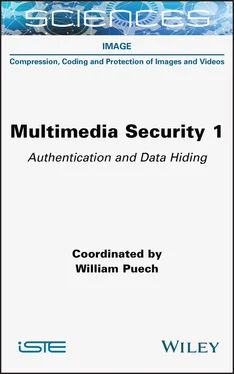

 , where γ typically varies between 1.8 and 2.2. The idea behind this procedure is not only to enhance the contrast of the image but also to encode more precisely the information in the dark areas, which are too dark in the raw image.
, where γ typically varies between 1.8 and 2.2. The idea behind this procedure is not only to enhance the contrast of the image but also to encode more precisely the information in the dark areas, which are too dark in the raw image.







